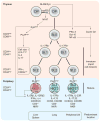Transcriptional regulation of the NKT cell lineage
- PMID: 23402834
- PMCID: PMC3647452
- DOI: 10.1016/j.coi.2013.01.003
Transcriptional regulation of the NKT cell lineage
Abstract
How expression of canonical semi-invariant TCRs leads to innate-like effector differentiation is a central enigma of NKT cell development. NKT thymic precursors undergo elevated TCR signals leading to increased Egr2, which directly induces their signature transcription factor, PLZF. PLZF is necessary and sufficient to induce a multipotent, unbiased effector program that precedes terminal differentiation into T-bet(high) NK1.1(+) (NKT1) cells and recently identified NKT2 and NKT17 sublineages. Major variations in polarized NKT sublineages have been uncovered in different mouse strains and in several mutants, with direct impact on NKT cell function but also, unexpectedly, on the development and function of conventional T cells.
Copyright © 2013 Elsevier Ltd. All rights reserved.
Figures

Similar articles
-
Elevated and sustained expression of the transcription factors Egr1 and Egr2 controls NKT lineage differentiation in response to TCR signaling.Nat Immunol. 2012 Feb 5;13(3):264-71. doi: 10.1038/ni.2230. Nat Immunol. 2012. PMID: 22306690 Free PMC article.
-
NKT sublineage specification and survival requires the ubiquitin-modifying enzyme TNFAIP3/A20.J Exp Med. 2016 Sep 19;213(10):1973-81. doi: 10.1084/jem.20151065. Epub 2016 Aug 22. J Exp Med. 2016. PMID: 27551157 Free PMC article.
-
PLZF Acetylation Levels Regulate NKT Cell Differentiation.J Immunol. 2021 Aug 1;207(3):809-823. doi: 10.4049/jimmunol.2001444. Epub 2021 Jul 19. J Immunol. 2021. PMID: 34282003
-
The Role of Adaptor Proteins in the Biology of Natural Killer T (NKT) Cells.Front Immunol. 2019 Jun 25;10:1449. doi: 10.3389/fimmu.2019.01449. eCollection 2019. Front Immunol. 2019. PMID: 31293596 Free PMC article. Review.
-
iNKT cells: innate lymphocytes with a diverse response.Crit Rev Immunol. 2014;34(1):81-90. doi: 10.1615/critrevimmunol.2014010088. Crit Rev Immunol. 2014. PMID: 24579702 Review.
Cited by
-
TET proteins regulate Drosha expression and impact microRNAs in iNKT cells.bioRxiv [Preprint]. 2024 Jul 31:2024.07.31.605991. doi: 10.1101/2024.07.31.605991. bioRxiv. 2024. Update in: Front Immunol. 2024 Sep 19;15:1440044. doi: 10.3389/fimmu.2024.1440044. PMID: 39131272 Free PMC article. Updated. Preprint.
-
Mitochondrial metabolism is essential for invariant natural killer T cell development and function.Proc Natl Acad Sci U S A. 2021 Mar 30;118(13):e2021385118. doi: 10.1073/pnas.2021385118. Proc Natl Acad Sci U S A. 2021. PMID: 33753493 Free PMC article.
-
Circulating mature granzyme B+ T cells distinguish Crohn's disease-associated axial spondyloarthritis from axial spondyloarthritis and Crohn's disease.Arthritis Res Ther. 2021 May 22;23(1):147. doi: 10.1186/s13075-021-02531-w. Arthritis Res Ther. 2021. PMID: 34022940 Free PMC article.
-
Invariant Natural Killer T and Mucosal-Associated Invariant T Cells in Asthmatic Patients.Front Immunol. 2018 Jul 30;9:1766. doi: 10.3389/fimmu.2018.01766. eCollection 2018. Front Immunol. 2018. PMID: 30105031 Free PMC article. Review.
-
Selective activation and expansion of regulatory T cells using lipid encapsulated mRNA encoding a long-acting IL-2 mutein.Nat Commun. 2022 Jul 5;13(1):3866. doi: 10.1038/s41467-022-31130-9. Nat Commun. 2022. PMID: 35790728 Free PMC article.
References
-
- Savage AK, Constantinides MG, Han J, Picard D, Martin E, Li B, Lantz O, Bendelac A. The transcription factor PLZF directs the effector program of the NKT cell lineage. Immunity. 2008;29:391–403. This and the next reference represent the first identification of the signature transcription factor PLZF and the characterization of its role in directing innate-like effector differentiation. - PMC - PubMed
-
- Bendelac A, Savage PB, Teyton L. The biology of NKT cells. Annu Rev Immunol. 2007;25:297–336. - PubMed
-
- Godfrey DI, Stankovic S, Baxter AG. Raising the NKT cell family. Nat Immunol. 2010;11:197–206. - PubMed
-
- Kreslavsky T, Savage AK, Hobbs R, Gounari F, Bronson R, Pereira P, Pandolfi PP, Bendelac A, von Boehmer H. TCR-inducible PLZF transcription factor required for innate phenotype of a subset of gammadelta T cells with restricted TCR diversity. Proc Natl Acad Sci U S A. 2009;106:12453–12458. - PMC - PubMed
Publication types
MeSH terms
Substances
Grants and funding
LinkOut - more resources
Full Text Sources
Other Literature Sources
Miscellaneous

